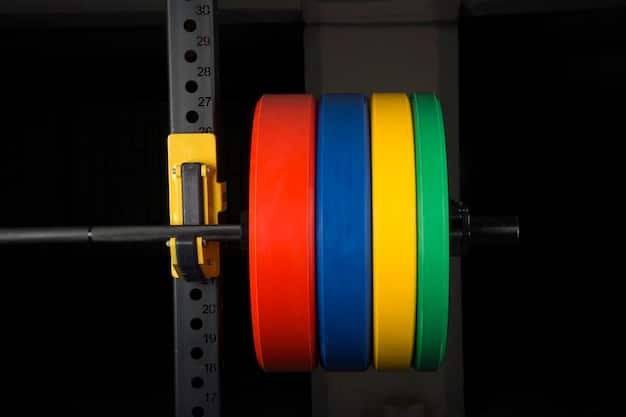Advanced Training Techniques for Experienced Lifters

For experienced lifters, advanced training techniques like drop sets and supersets are critical for breaking through plateaus and stimulating new muscle growth by significantly increasing training intensity and volume within workouts.
For those who have moved past the initial stages of lifting and are seeking new challenges, the realm of Advanced Training Techniques: Drop Sets, Supersets, and More for Experienced Lifters offers a path to continued progress. These methods are not just about adding intensity; they are about intelligently manipulating training variables to stimulate muscular hypertrophy, improve strength, and shatter perceived limitations. By embracing these sophisticated strategies, seasoned lifters can unlock new levels of physical development.
The Science Behind Intensity: How Advanced Techniques Work
Understanding how advanced training techniques manipulate the body’s physiological responses is crucial for their effective application. These methods are designed to increase time under tension, enhance metabolic stress, and push muscle fibers beyond typical fatigue thresholds. By maximizing these stimuli, they force adaptation and ultimately, growth.
Each technique, from drop sets to supersets, targets specific mechanisms of muscle growth. The core principle involves inducing greater physiological stress than conventional straight sets. This stress translates into a stronger signal for the body to repair and rebuild muscle tissue, leading to increased size and strength.
Metabolic Stress and Muscle Damage
Advanced techniques excel at generating two primary drivers of hypertrophy: metabolic stress and muscle damage. Metabolic stress is accumulated through the buildup of metabolites like lactate and hydrogen ions, which contribute to the “pump” sensation. Muscle damage, on the other hand, refers to microscopic tears in muscle fibers, often associated with delayed onset muscle soreness (DOMS). Both play crucial roles in signaling muscle adaptation.
- Increased lactate accumulation enhances anabolic signaling.
- Greater muscle fiber recruitment overcomes plateaus.
- Elevated systemic hormonal responses support hypertrophy.
- Improved nutrient delivery to working muscles.
By pushing muscles to their limits, these techniques also improve the body’s ability to clear waste products and deliver nutrients more efficiently. This internal optimization further supports recovery and subsequent growth, making the muscle more resilient and capable over time. The systematic overload ensures that the body never fully adapts to a single stimulus, constantly forcing it to improve.
Beyond the immediate physiological benefits, these techniques also build mental toughness. The ability to push through discomfort and maintain focus under extreme fatigue is a skill developed through consistent application of these advanced methods. This mental fortitude often translates into other areas of life, reinforcing the holistic benefits of dedicated training.
Mastering Drop Sets: Maximizing Muscle Fiber Recruitment
Drop sets are an invaluable tool for experienced lifters aiming to maximize muscle fiber recruitment and induce extreme fatigue within a single set. This technique involves performing an exercise to failure with a certain weight, then immediately reducing the weight and continuing with more repetitions until failure again. This process can be repeated multiple times, typically 2-3 drops, allowing you to bypass a single point of muscular failure.
The effectiveness of drop sets lies in their ability to exhaust muscle fibers that might not be fully stimulated during conventional sets. By reducing the load, you are able to continue the set, recruiting additional muscle fibers and subjecting them to greater total time under tension and metabolic stress. This intense stimulus is a powerful trigger for hypertrophy.
Implementing Drop Sets Safely and Effectively
While highly effective, drop sets can be very taxing on the central nervous system and should be used judiciously. They are best applied to isolation exercises or machine-based movements where weight changes can be made quickly and safely. For compound movements, careful planning and potentially a spotter are essential to ensure safety.
- Choose one exercise per muscle group for drop sets.
- Opt for exercises where weight can be quickly reduced (e.g., dumbbells, machines).
- Reduce weight by 10-25% for each subsequent drop.
- Aim for 2-3 drops per set, pushing to failure on each segment.
Selecting the right exercises is paramount. Exercises like lateral raises, triceps pushdowns, or leg extensions are ideal candidates as they allow for continuous tension and quick weight adjustments. Free-weight compound movements like squats or bench presses are generally less suitable due to safety concerns and the time required to unload plates.
Proper form must be maintained throughout the entire drop set, even as fatigue mounts. Sacrificing form to lift heavier or squeeze out more reps can lead to injury and negate the benefits of the technique. Focus on controlled movements and a strong mind-muscle connection, even when your muscles are screaming for relief. The quality of contraction is more important than the quantity of reps beyond good form.
Supersets and Compound Sets: Efficiency and Intensity
Supersets involve performing two exercises back-to-back with little to no rest in between. This technique is excellent for increasing training density, elevating heart rate, and inducing a significant metabolic response. There are several types of supersets, each offering unique benefits for muscle growth and conditioning.
Traditionally, supersets are divided into exercises for opposing muscle groups (e.g., biceps and triceps) or for the same muscle group, targeting different aspects of it. Compound sets, a specific type of superset, involve performing two exercises for the *same* muscle group consecutively. Both amplify intensity and can significantly cut down workout duration while boosting calorie expenditure.
Types of Supersets and Their Benefits
- Antagonistic Supersets: Pairing opposing muscle groups (e.g., chest and back) allows one muscle group to recover while the other works. This enhances overall work capacity and can improve muscular balance.
- Agonist/Compound Supersets: Performing two exercises for the same muscle group (e.g., incline dumbbell press followed by flat dumbbell flyes) totally fatigues the targeted muscle, leading to profound metabolic stress and muscle pump.
- Pre-exhaust Supersets: An isolation exercise is followed by a compound exercise for the same muscle group (e.g., dumbbell flyes followed by bench press). This pre-fatigues the primary mover, ensuring it fails before accessory muscles.
- Post-exhaust Supersets: A compound exercise is followed by an isolation exercise for the same muscle group (e.g., bench press followed by dumbbell flyes). This allows the compound movement to be performed at maximum strength before breaking down the muscle further.
The choice of superset type depends on your training goals. For increased pump and metabolic stress, agonist supersets are ideal. For overall body conditioning and efficiency, antagonistic supersets are highly effective. Incorporating a variety of superset types ensures a well-rounded and challenging training program.

Rest periods between supersets should be minimal, ideally just enough time to transition between exercises. The goal is to keep the intensity high and the heart rate elevated. However, ensure you are still able to maintain good form throughout both exercises. Quality of movement always takes precedence over speed or sheer volume.
Rest-Pause Training: Elevating Strength and Hypertrophy
Rest-pause training is a high-intensity technique designed to extend a set beyond typical failure by incorporating brief rest periods. Instead of completely ending a set when fatigue sets in, you briefly pause, allowing partial recovery of ATP (adenosine triphosphate) stores, and then continue with more repetitions. This method is incredibly effective for accumulating a high volume of work in a short amount of time, pushing muscles to their absolute limit.
The beauty of rest-pause lies in its ability to recruit and fatigue high-threshold motor units that might not be fully engaged during standard sets. By repeatedly pushing past initial failure points, you force these powerful muscle fibers into action, leading to significant gains in both strength and hypertrophy. It’s an advanced way to truly maximize effort within each set.
Applying Rest-Pause for Maximum Impact
There are several ways to implement rest-pause training, but a common approach involves performing a set to near failure, resting for a short duration (typically 10-20 seconds), and then performing another short burst of repetitions. This sequence can be repeated 2-3 times within a single “set.”
- Perform 6-10 repetitions of an exercise to near failure.
- Rack the weight and rest for 10-20 seconds.
- Perform another 2-4 repetitions with the same weight to failure.
- Repeat the rest and additional reps sequence 1-2 more times.
Due to its intense nature, rest-pause training should be used sparingly, perhaps once a week for a specific muscle group or exercise. It’s particularly effective for compound movements like squats, deadlifts, or bench presses, where the ability to grind out extra reps after a brief rest can be highly beneficial for strength gains. However, it can also be applied to isolation exercises to completely exhaust a muscle.
Ensure you have a spotter when attempting rest-pause with heavy compound lifts, as safety is paramount. The goal is to push your limits, not to get injured. Listen to your body and don’t overdo it, especially when first experimenting with this technique. Overreaching is a real concern, so manage your recovery carefully.
Pyramid Training: Progressive Overload in Practice
Pyramid training is a versatile and widely used technique that allows lifters to systematically vary their training intensity and volume within a single exercise. It involves either increasing or decreasing the weight while simultaneously decreasing or increasing the repetitions over successive sets. This method is a fantastic way to train multiple rep ranges within one exercise, targeting both strength and hypertrophy.
There are two main types of pyramid training: ascending and descending (or reverse) pyramids. Ascending pyramids involve starting with lighter weights and higher reps, gradually increasing the weight and decreasing the reps. Descending pyramids flip this, starting heavy and low reps, then decreasing weight and increasing reps.
Ascending vs. Descending Pyramids
- Ascending Pyramid: Start with a lighter weight for more reps, then progressively increase the weight and decrease the reps in subsequent sets. This warms up the muscles effectively and allows for heavy lifting towards the end of the sequence. For example: Set 1 (12 reps), Set 2 (10 reps), Set 3 (8 reps), Set 4 (6 reps), all with increasing weight.
- Descending Pyramid (Reverse Pyramid): Begin with your heaviest weight for low reps, then decrease the weight and increase the reps in subsequent sets. This allows you to tackle the heaviest loads when you are freshest, potentially leading to greater strength gains. For example: Set 1 (4-6 reps), Set 2 (8-10 reps), Set 3 (10-12 reps), all with decreasing weight.
Descending pyramids are often favored by advanced lifters as they prioritize strength. By hitting the heaviest sets first, when fatigue is minimal, you can move maximum weight. Ascending pyramids are excellent for building work capacity and can be useful for those wanting a more gradual progression to heavier loads within a given session.

Pyramid training effectively integrates the principle of progressive overload, which is fundamental to long-term muscle growth. By varying the stimulus, you can ensure that muscles are challenged in different ways, preventing plateaus and promoting continuous adaptation. It’s a classic technique for a reason: it works.
Time Under Tension (TUT) and Eccentric Training
Time Under Tension (TUT) refers to the total duration a muscle is under stress during a set. By manipulating the speed of your repetitions, particularly the eccentric (lowering) phase, you can significantly increase TUT and stimulate muscle growth through enhanced mechanical tension and muscle damage. This focus on controlled, deliberate movements, rather than simply lifting and lowering quickly, is a hallmark of advanced training.
Eccentric training, a specific application of TUT, emphasizes the lengthening phase of a muscle contraction. During this phase, muscles can handle significantly more force than during the concentric (lifting) phase. By slowing down the eccentric portion of a lift, you can create greater muscle damage, which is a powerful stimulus for hypertrophy.
Maximizing TUT and Eccentric Loading
To effectively implement TUT and eccentric training, you need to be deliberate with each repetition. Forget about momentum and focus on controlled, slow movements, especially during the lowering phase. A common tempo might be 2 seconds up (concentric), 0-1 second pause, and 3-4 seconds down (eccentric).
- Use a 3-4 second count for the eccentric (lowering) phase of each repetition.
- Maintain constant tension; avoid locking out at the top or bottom unless strategically planned.
- Prioritize form over weight; lighter loads with perfect technique are more effective.
- Consider supersetting a concentric-focused exercise with an eccentric-focused one for maximum impact.
Eccentric training is particularly effective for breaking through strength plateaus and adding lean mass. However, it can cause significant muscle soreness due to the increased muscle damage. Therefore, it should be integrated cautiously into your program, allowing for adequate recovery time between sessions focusing on eccentric overload.
The mindful execution of each rep, focusing on the muscle contraction rather than just moving the weight, fundamentally changes the training stimulus. This approach shifts the focus from external weight to internal muscular effort, which is essential for advanced development.
Periodization and Program Integration: The Bigger Picture
Incorporating advanced training techniques effectively requires a strategic approach, not just random application. Periodization, the systematic planning of training to maximize performance and prevent overtraining, is key. It involves structuring your training into different phases, varying intensity, volume, and exercise selection over time.
For experienced lifters, periodization helps prevent plateaus, minimizes injury risk, and ensures continuous progress. It allows for the intelligent integration of high-intensity techniques like drop sets and supersets during specific phases, followed by periods of lower intensity to facilitate recovery and adaptation. Without a structured plan, even the best techniques can lead to burnout or injury.
Structuring Advanced Training into Your Program
When integrating these techniques, it’s crucial to avoid overtraining. Advanced methods are intense and demand more recovery. Therefore, they should be used strategically, perhaps focusing on one or two techniques per workout or rotating them weekly.
- Phase integration: Design specific training blocks (e.g., mesocycles) where advanced techniques are emphasized for 3-6 weeks, followed by a deload or lower intensity phase.
- Strategic placement: Use advanced techniques towards the end of a workout, after your main compound lifts, to maximize metabolic stress and pump without compromising strength performance.
- Recovery focus: Emphasize nutrition, hydration, and sleep more than ever when implementing high-intensity training. These are non-negotiable for adaptation.
- Listen to your body: Pay attention to signs of overtraining, such as persistent fatigue, decreased performance, or mood changes. Adjust your program accordingly.
A well-designed periodized program might include a hypertrophy phase heavily utilizing drop sets and supersets, followed by a strength phase emphasizing heavy lifts with rest-pause, and then a deload to prepare for the next cycle. This cyclical nature ensures adaptations continue and the body remains responsive to training stimuli.
Ultimately, the effectiveness of any advanced technique lies in its thoughtful application within a broader training philosophy. These are tools to be used wisely, not haphazardly. For the experienced lifter, mastering their integration is as crucial as mastering their execution.
| Key Technique | Brief Description |
|---|---|
| 💪 Drop Sets | Reducing weight to continue reps after failure, maximizing fiber recruitment. |
| ⚡ Supersets | Two exercises back-to-back with minimal rest, boosting intensity and efficiency. |
| ⏱️ Rest-Pause | Brief rests within a set to extend it beyond initial failure for more reps. |
| 📈 Pyramid Training | Varying weight and reps across sets to hit different strength/hypertrophy ranges. |
Frequently Asked Questions About Advanced Training Techniques
These techniques are primarily for experienced lifters who have built a solid foundation of strength and proper form. Beginners should focus on mastering basic compound movements and consistent progressive overload before attempting these high-intensity methods, which can be very demanding on the body and mind.
Due to their intensity, advanced techniques should be used sparingly. Incorporating them into 1-2 exercises per workout, or dedicating specific mesocycles (e.g., 4-6 weeks) to higher intensity training, followed by periods of lower intensity, is a common and effective approach to prevent overtraining and ensure continuous progress.
The primary benefits include breaking through plateaus, stimulating new muscle growth, increasing muscular endurance, and enhancing overall training efficiency. They provide a novel stimulus that forces the body to adapt beyond what traditional straight sets might achieve, leading to greater strength and hypertrophy.
Absolutely. Advanced techniques place significant stress on the central nervous system and muscles. Without adequate rest, nutrition, and strategic planning (like periodization), they can quickly lead to overtraining, manifested as decreased performance, chronic fatigue, increased injury risk, and even hormonal imbalances. Careful management is crucial.
There isn’t one “best” technique, as effectiveness varies by individual and plateau type. However, drop sets are excellent for exhausting muscle fibers beyond typical failure, while rest-pause training is superb for accumulating volume and strength with heavy loads. Both are powerful tools for introducing a new, challenging stimulus to stalled progress.
Conclusion
For the experienced lifter, the journey of physical development is one of continuous adaptation and challenging the status quo. Incorporating advanced training techniques like drop sets, supersets, rest-pause, and pyramid training offers a sophisticated toolkit to break through plateaus and catalyze new levels of strength and muscularity. These methods are not just about raw intensity; they are about intelligently manipulating training variables to optimize physiological responses, ensuring that your body continues to respond and grow. By understanding the science behind each technique, integrating them judiciously within a periodized framework, and prioritizing recovery, seasoned athletes can unlock their full potential and continue their impressive journey of physical transformation.





